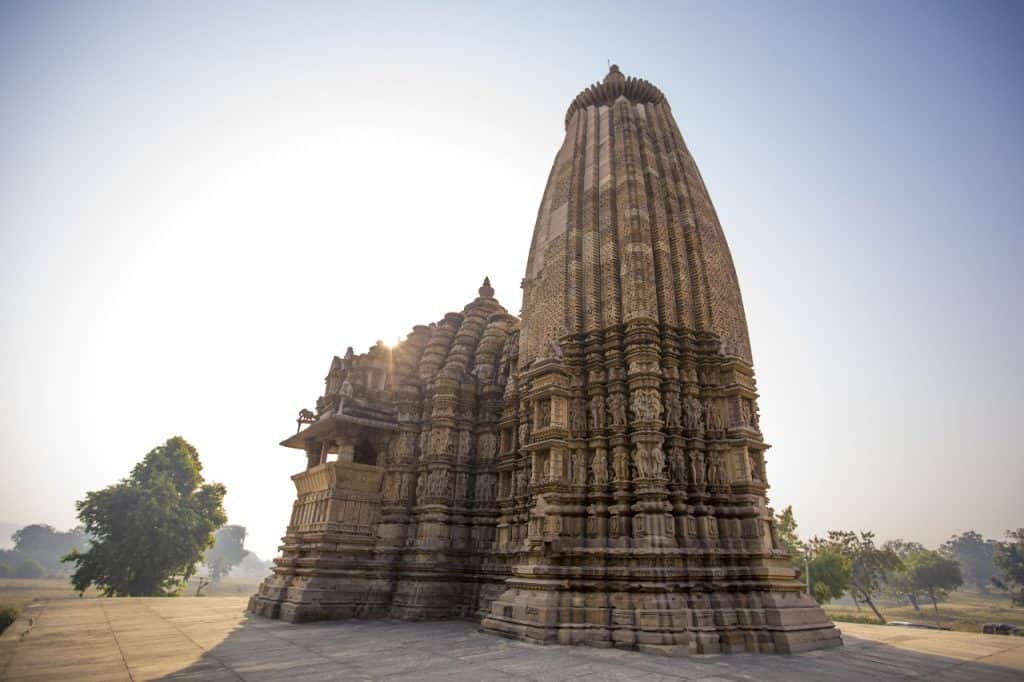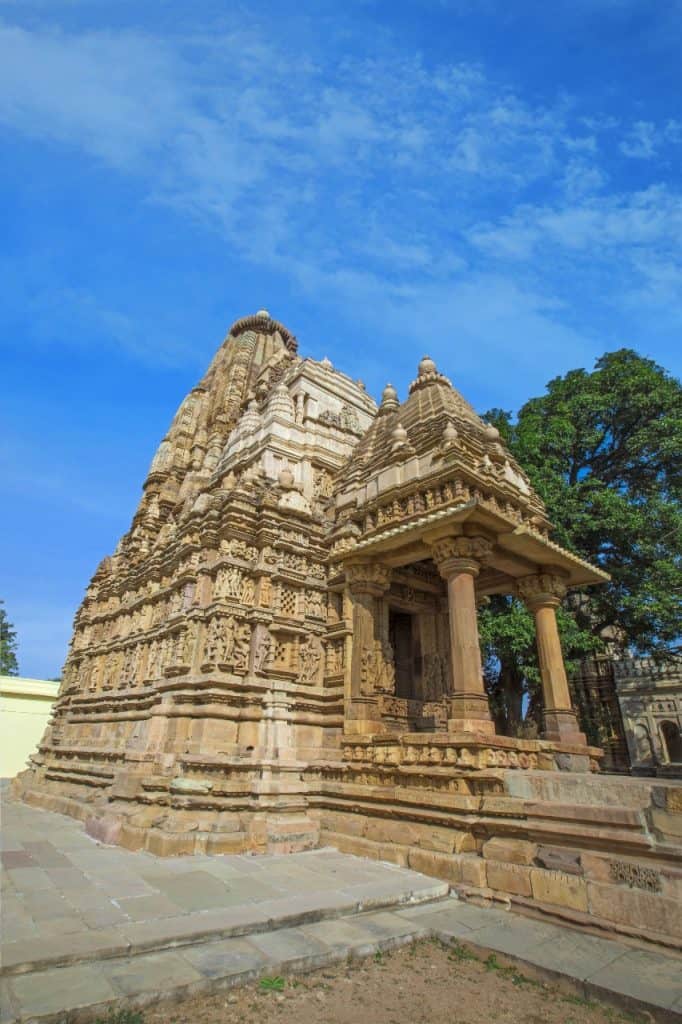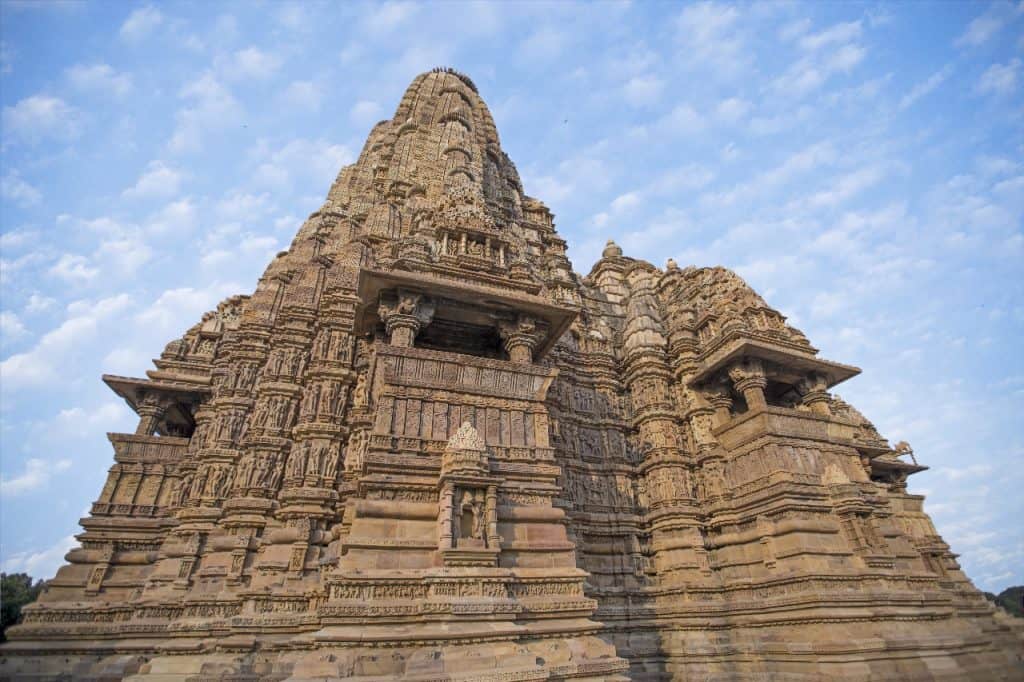Khajuraho, which is located in the northeastern part of Madhya Pradesh and is a popular tourist destination, it’s one of India’s UNESCO World Heritage Sites.

One of India’s most well-known towns, Khajuraho, is situated in the Chatarpur district of the Madhya Pradesh state. Many medieval-era Hindu and Jain temples may be seen scattered around Khajuraho. Sensual sculptures that have drawn tourists for decades are what really set these temples apart.
For many centuries, scholars and tourists have been captivated by the vivid and captivating frescos.
Established during the Chandella dynasty, which peaked between 950 and 1050, the temples of Khajuraho were constructed. There are now just around 20 temples, divided into three separate groupings and associated with the two religions of Jainism and Hinduism.
They successfully combine sculpture and architecture. Numerous sculptures that rank among the best works of Indian art adorn the Temple of Kandariya.
The group of temples of Khajuraho affirms the perfection of northern Indian temple craftsmanship and architecture of the Chandella tradition who ruled the locale within the 10th and 11th centuries CE. Disseminated over a region of 6 square km in a beautiful landscape, the temples that shape the western, eastern, and southern clusters of the Khajuraho Gather of Landmarks are uncommon surviving cases that show the originality and tall quality of Nagara-style temple design.
In terms of layout and physical form, the Khajuraho group of monuments represents the pinnacle of the development of temple architecture in North India. Built of sandstone, the temple is raised from its surroundings by a highly decorative terraced platform or Jagat which stands as a body or jangha topped with a tower or shikhara.
The main tower at the top is vertically accentuated by several adjacent smaller towers, each of which symbolizes Mount Kailasa, the abode of the gods.

The plan of the temples shows the spatial hierarchy of axially aligned interconnected spaces. The temples are entered through an ornate entrance porch (ardhamandapa), which leads to the main hall (mandapa), through which one accesses the vestibule (antarala) before reaching the sanctum (garbhagriha).
The main halls of the temples were often accompanied by lateral transepts with projecting windows as well as a circumambulatory path around the sanctum. Larger temples had an additional pair of transepts and were accompanied by subsidiary shrines on the four corners of their jagati.
Temples here are renowned for the way sculpture and architecture blend together harmoniously. Every surface is heavily engraved with both non-anthropomorphic and anthropomorphic motifs that represent secular and holy subjects. The holy belief system is reflected in the sculptures that show worshipping couples, clans and deities, and acts of devotion.
Other subjects, such as images of homes, instructors and students, musicians and dancers, and romantic couples, reflect social life. The master craftsmen’s exquisite composition and skill endow the stone surfaces of the Khajuraho temples with an uncommon brightness and warmth that resonates with human emotions.
The site’s complex is a singular work of art, both for its incredibly inventive design and its exquisitely carved décor, which consists of a mythical collection of several amusing situations that may be interpreted in a variety of ways, whether they are religious or profane.
Here travellers can see remarkable work of imagination, both for its incredibly original architecture and its exquisitely carved decor, which features a famous repertory of diverse entertainment scenarios that include scenes incapable of being explained, whether they are religious or profane.
Here the temples are a wonderful testament to the Chandella civilization, which flourished in central India not too long after the Delhi Sultanate was established at the beginning of the 13th century CE.

Apart from the artistic designs, there are various festivals like the Khajuraho dance festival which is held in the Khajuraho temple complex itself. It’s a seven-day long dance festival that is organised to revive and preserve the Indian cultural legacy.
The event was founded in 1975 with the goal of honoring Indian traditional dance styles’ expressiveness. Among the classical dance styles are Kathak, Kathakali, Bharatnatyam, Kuchipudi, Odissi, Manipuri, and Mohiniyattam. Prominent classical dancers from around the nation and beyond assemble for this seven-day celebration. It usually takes place in February.
The ideal time to visit here is from September to March. Therefore the months of October to February are the most recommended, during these days the average temperature is usually 30°C. Khajuraho has excellent transportation connections to other regions of the nation. Khajuraho is only 5 kilometres from the main city and has an airport to accommodate the large number of visitors who visit this location.
Flights from Mumbai, Delhi, Agra, and Varanasi arrive often. An additional means of transportation inside the city is the Khajuraho Railway Station. Additionally, there are interstate bus routes that link to Uttar Pradesh. To go to the city, one can also hire a cab or a taxi.
Read more: Latest



